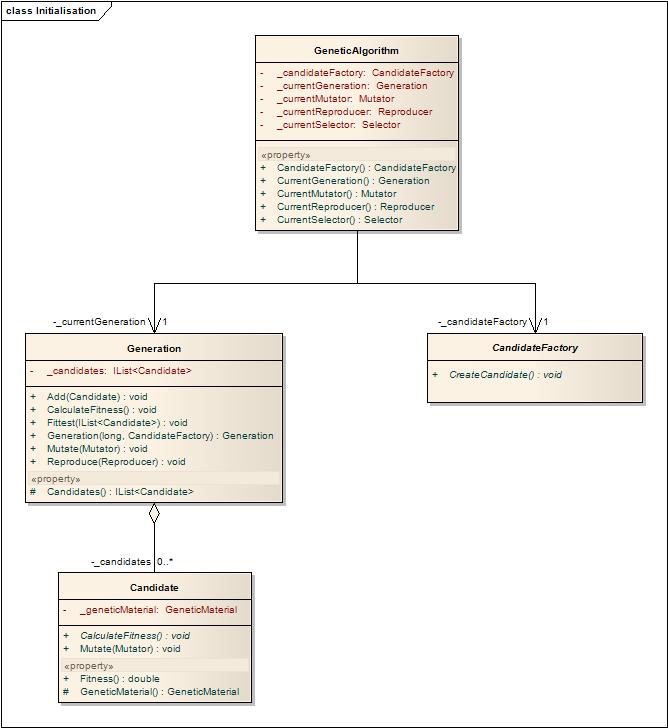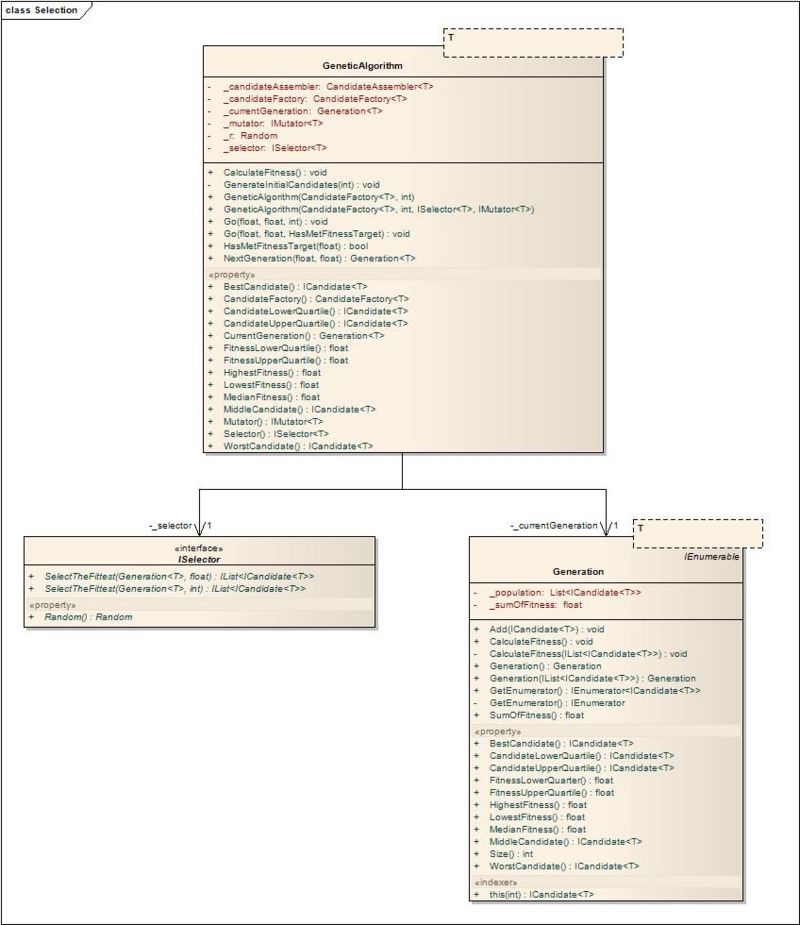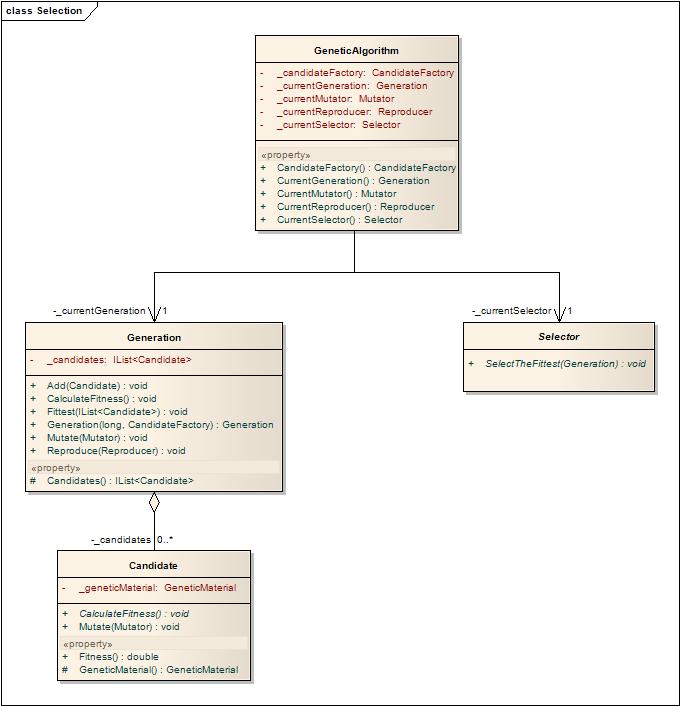Portions of a generic genetic-algorithms library
(→Introduction) |
(→Candidate Migration) |
||
| Line 38: | Line 38: | ||
===Candidate Migration=== | ===Candidate Migration=== | ||
| + | When multiple generations are evolved in parallel, the genetic algorithm may migrate candidates between these generations. The fittest candidates are copied from one generation, and are used to replace the least fit in another generation. The Matlab genetic algorithms libraries allow this to be performed in one of two ways. | ||
==A First Attempt== | ==A First Attempt== | ||
Revision as of 07:22, 29 September 2008
Contents |
Introduction
Over the last few months I have become interested in problems associated with modelling non-linear systems. This interest has lead me to look into artificial neural networks, and how they can be trained using genetic algorithms. For those with an interest in this area, development environments like Matlab provide an ideal platform for quick implementation and testing [1]. However, at deployment time, a Matlab script is of little use to clients with a limited budget [2], or to developers targeting embedded platforms, or non-x86 and non-SPARC architectures [3].
Genetic Algorithms for Dummies
Disclaimer about how much I actually know about genetic algorithms. [Damn it Jim I'm a software engineer, not an AI specialist!]
Requirements
The intention of this project is to provide a framework that is capable of mimicking the back-end behaviour of the Matlab genetic algorithms library. The framework should allow a client to adapt and extend the framework to suit their specific needs. The framework should:
- Allow optimizing of client defined types
- Allow client defined selection, reproduction, and mutation strategies
- Provide the easy removal of unused strategies for the purposes of reducing the size of the final distributable
Design
Candidate Creation
A major goal of the framework is to provide the ability to optimise client defined types. The client should be able to extend the framework to define a candidate, its DNA, and the process by which these are created. To facilitate this, the framework should define a contract by which both the framework can work and the client can inherit or realise. This is design by contract. This contract should define abstract entities that include:
- A candidate
- A candidate's DNA
- A class responsible for candidate creation
- A class responsible for DNA creation
Here we have a cascaded pair of abstract classes responsible for the creation of a cascaded pair of abstract products. This is the contractual portion of a factory method. The client is left to implement the concrete creator, and products as they please.
Future Extensions
Leaving the creation of concrete chromosomes entirely up to the client was perhaps not the best approach. There are some fundamental types of chromosome that could be defined within the framework, and extended by the client. These include value-types like byte, float, integer, double, etcetera.
Calculating Fitness
Having provided the client with the ability to define candidates, the client should also be able to assess the fitness of these candidates. As the fitness of a candidate is completely dependent on the context of the application, the framework can have no knowledge of how this is calculated. As with candidate creation, the fitness calculation will be defined using a contract in the form of an interface. The framework will define its work in terms of this interface, the client can realise this interface.
The contract for fitness calculations is defined by the IFitnessInspector interface.
Selecting the Fittest
Once the fitness of all candidates has been assessed, the candidates that will live on to the next generation are selected. There are many methods by which candidates can be selected. The selection methods presented in the Matlab genetic algorithms library should be reproduced here. The framework should also allow for client defined selection methods.
Creating Candidates via Reproduction
With the fittest candidates in-hand, the genetic algorithm must go on to combine the DNA of these candidates to create new ones. This reproduction process populates the next generation. As with the selection process, the Matlab genetic algorithm libraries provide several possible ways in which to create new candidates via reproduction. The framework should mimick these, and also allow for client defined reproduction strategies.
Mutating Candidates
Following reproduction, the genetic algorithm must mutate some proportion of the population. As with the reproduction and selection processes, the Matlab genetic algorithm libraries describe several ways in which candidates may be mutated. The framework should reproduce these, and also allow for client defined mutation strategies.
Candidate Migration
When multiple generations are evolved in parallel, the genetic algorithm may migrate candidates between these generations. The fittest candidates are copied from one generation, and are used to replace the least fit in another generation. The Matlab genetic algorithms libraries allow this to be performed in one of two ways.
A First Attempt
This is the starting point - something I put together around 6 months ago.
My first working attempt at a generic genetic-algorithms library is shown in Fig. 1. This section will dissect and critique portions of the initial library design.

Creating New Candidates
A set of candidates are required to initiate the algorithm. The creation of this initial set or generation of candidates is the responsibility of the library user.
The First Attempt
In the first attempt, a modified Factory pattern was used here, this was taken from a Microsoft Patterns and Practices article by Doug Purdy. An abstract factory class is provided by the library, the user is expected to provide a concrete candidate factory class.
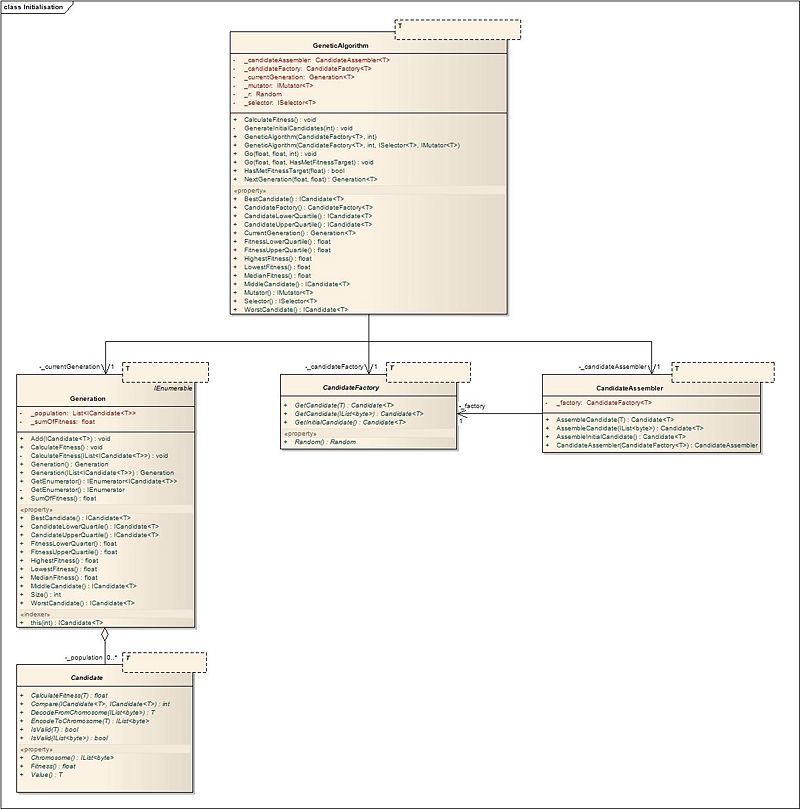
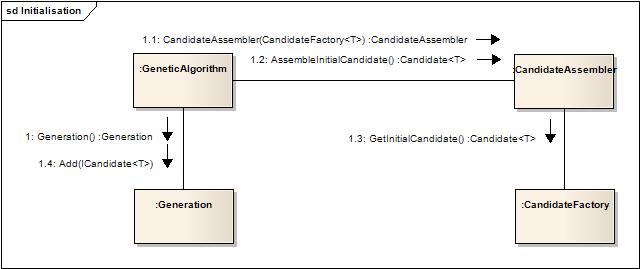
A New Design
To facilitate building candidates, the user should provide the genetic algorithm with a concrete candidate factory.
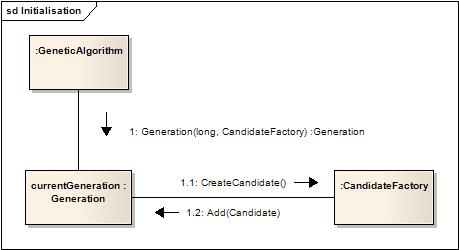
Selection of the Fittest
Upon creating a generation of candidates, the process of creating a new generation begins. To start, a portion of the candidates are selected from the current generation based on fitness. The fitness of each candidate is calculated, then one of several candidate selection algorithms is applied to the current generation. The selection strategy may vary per iteration. The library user is responsible for choosing and configuring the selection strategy.
The First Attempt
Fitness calculations are known about by
- the GeneticAlgorithms class
- the Generation class
- the Candidate class

A New Design
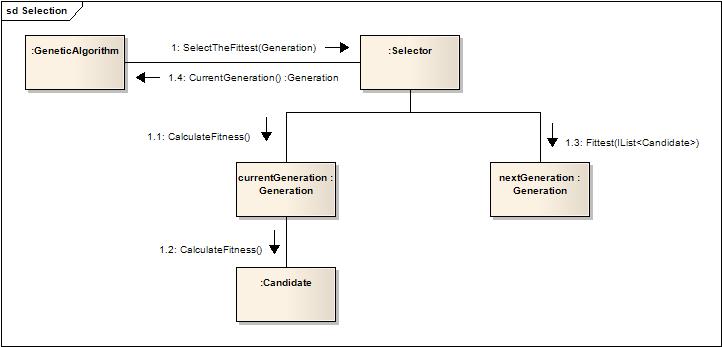
Creating New Candidates via Reproduction
A new generation begins by selecting a set of candidates based on fitness. These candidates become the parents in the new generation; they reproduce to create a new set of genetically similar candidates. Reproduction, also known as crossover, is performed using one of several possible crossover algorithms. The same reproduction strategy is usually applied to the entire generation in any one iteration. It is often kept constant throughout the algorithm life-cycle. The library user is responsible for choosing the crossover strategy.
The First Attempt
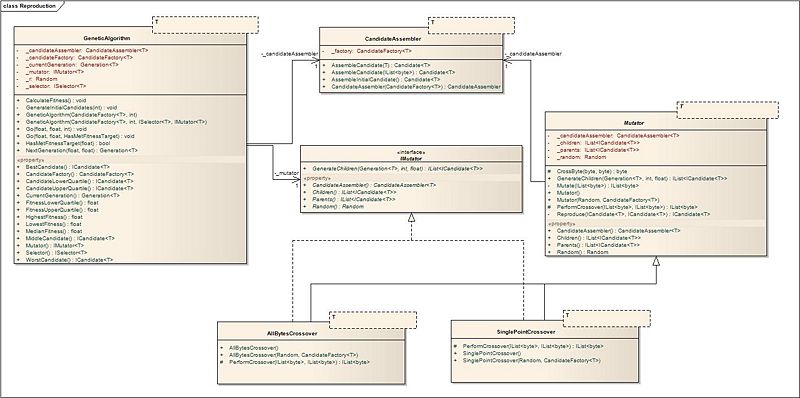
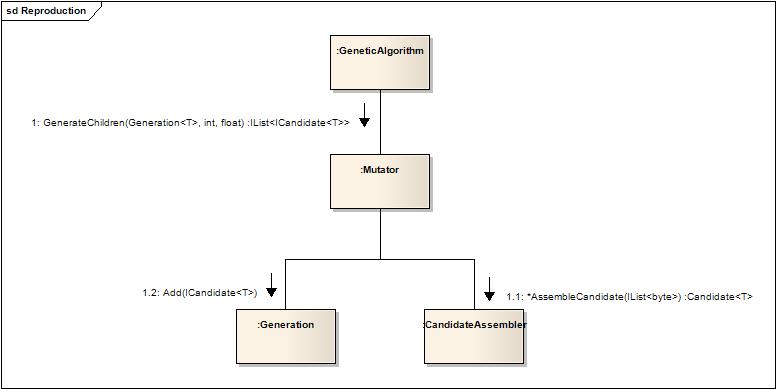
A New Design
Mutating Candidates
Following the reproduction process, a proportion of the children produced may be mutated. In mutation, there are two responsibilities. One is performing the mutation - defining this algorithm is the responsibility of the library user. The other is selecting candidates for mutation - here the library user is responsible for choosing from one of several selection strategies defined within the library.
A New Design
A New Design
Core Class Structure

Communications
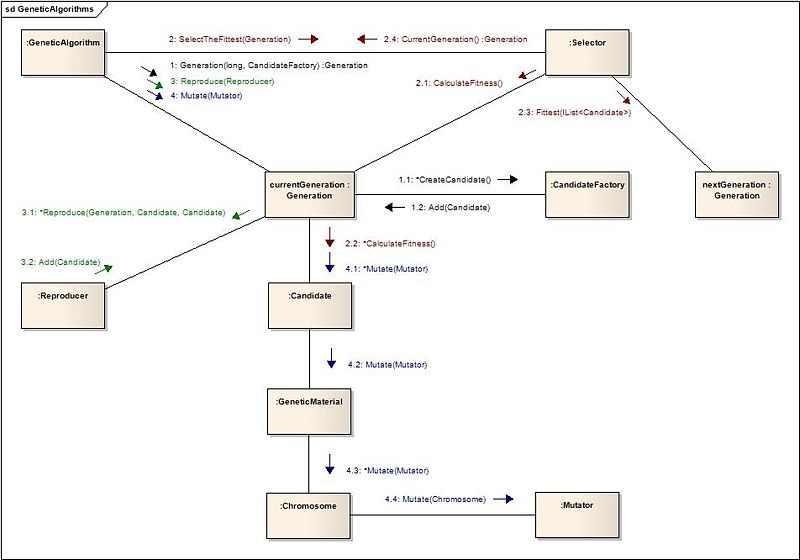
References
- ^ http://www.mathworks.com/access/helpdesk/help/toolbox/gads/
- ^ http://www.mathworks.com/products/matlab/pricing_licensing.html?tab=com
- ^ http://www.mathworks.com/products/matlab/requirements.html
